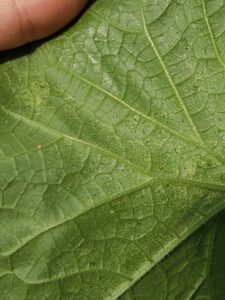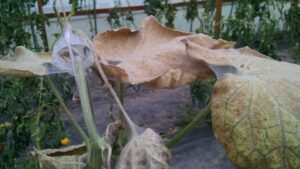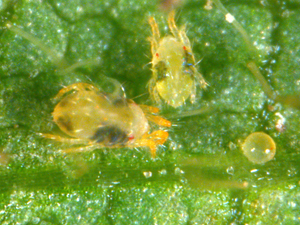Two-spotted spider mites (TSSM) are one of the most common mite pests occurring throughout the world. They are known to feed on over 300 plant species, including tomatoes, cucumbers, melons, grapes, apples, and a variety of common flower and weed species. They disperse by walking or floating on the wind currents.
Early infestations can be spotted by scouting the leaves for the characteristic stippling that occurs because of mite feeding. Mites feed on the plant at the cellular level, removing photosynthates and creating a stippling pattern on the leaves. This looks like white/yellow speckles on the upper surface of the leaves and on the underside (Figure 1). As infestations build you will be able to spot the characteristic webbing that these mites build, giving them their common name (Figure 2). TSSM can be found on the underside of leaves with a 10X hand lens (Figure 3). The adults are a pale green to yellowish color, or almost appear translucent, with two black spots on their back. Eggs and nymphs are present and overlapping with adults. The eggs are very small yellowish or translucent circles and the nymphs are yellowish to green in color. Spots are not present until they are mature.

Figure 1. Stippling feeding damage on the underside of a cucumber leaf, caused by TSSM infestations. (Photo by: John Obermeyer.)

Figure 2. The characteristic webbing produced by spider mites acts as a superhighway for movement and dispersal.

Figure 3. The characteristic webbing produced by spider mites acts as a superhighway for movement and dispersal.
This time of year, following the heat and drought that many of us have been experiencing, you will begin to notice that this pest is thriving. Drought stressed plants and high heat create the perfect conditions for mites. And given their rapid life cycle, completing development from egg to reproductive adult in 5-20 days, populations may be exploding. Mite damage leads to chlorosis and ultimate leaf death. In addition, they can move directly onto the fruits of the plant and cause aesthetic damage to the exterior rind of melons and cucumbers. Under extreme pressure the entire plant can die.
There are a variety of natural enemies, especially predatory mite species, that help suppress the population. However, frequent insecticide sprays can lead to elimination of these predators. At the onset of infestations, you can purchase the species Phytoseiulus persimilis, from many biological control suppliers. This mite species is a specialist feeding on TSSM, they are voracious and move rapidly through the vegetation hunting TSSM. They have been deployed successfully in greenhouses to manage spider mites and more recently are deployed via drones in large-scale field production in crops including strawberries.
In some situations, you will need to turn to miticides for control. For a pest such as this, resistance management is key. Product rotation between the different classes available is necessary. I refer you back to a previous article where I discuss considerations when selecting the right miticide (July 15, 2021, Issue 693). In brief, there are five classes available to treat mites in watermelon/cantaloupe crops. These classes include the IRAC (Insecticide Resistance Action Committee) codes 3A (pyrethroids), 6 (avermectins), 10B (etoxazole), 20B (acequinocyl), 21A (meti acaricides) and 23 (tetronic acid and derivatives). The efficacy among the different classes varies and target different stages of development of the pest. We have had reports from growers in southern Indiana that group 6 (abamectin, Agri-mek®) and group 23 (tetronic acids, Oberon®) are no longer showing efficacy in their fields. This has not been confirmed but reinforces the need for product rotations. In conversations at our recent field day at Meigs Horticulture Farm, I have been told that one of the best strategies applied is a combination of etoxale (Zeal®, 10B) which has some translaminar activity and can move through plant tissues and fenpyroximate (Portal®, 21A) which has quick knockdown and will target all mobile stages of the pest. Using a silicone surfactant in the tank with the application will help improve coverage and control. Many of these products are limited in the number of applications you can apply per year, so be prepared to apply at the most crucial time and have materials on hand for rotation.